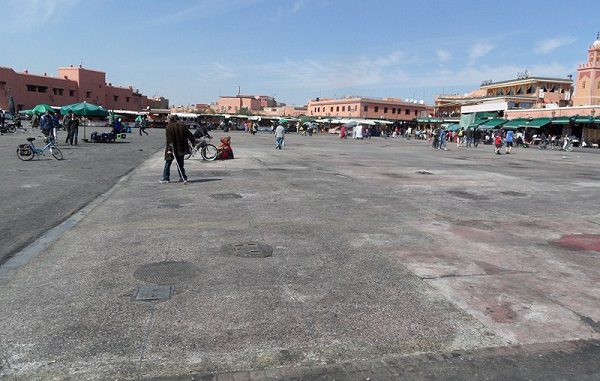
Marrakech could not be without its mythical place of Jamâa el Fna and its intangible heritage. It is for these buildings and its thousand-year-old folklore that tourists used to travel to Marrakech. Unfortunately, the square is still as sad and silent.
A commercial for the Royal Mansour shot recently in Jamâa El Fna gave false hopes to some, believing that the square had resumed its activities. This is not the case at the moment except for a few gargotes (which must respect the distance measures) and juice kiosks that are trying to “reanimate” the square. In vain! Because, the halqa artists who “make” the Jamâa el Fna square are still prohibited. Yet they are the ones who have made it a real place of attraction, day and night. In the aftermath of the health crisis, they found themselves without work (even if it was already very precarious). These artists, 350 in number, benefited from state aid for three months (800 DH/family/month) and then nothing more! “Each day that passes is an additional burden for us who are left to ourselves because we have nothing to feed our families. We just want them to let us work like what has been done elsewhere”, exclaims Mariam Amal, president of the association of artists of the Halqa in Jamâa el Fna. “We have given so much instead, for decades at the expense of our health and today, we are let down with so much indifference”.
As gatherings of more than 2 people are still prohibited, no official decision or exception for the Jamâa El Fna square has yet been announced. Before being a tourist place prized by foreigners, Jamâa el Fna is a place of relaxation for the Marrakchis themselves and for the Casablancais and rbatis passing through the ochre city. However, in these anxious times, very few inhabitants of the city go to this mythical place in many ways. As for internal tourists, travel restrictions have diverted them from Marrakech. Despite the easing measures announced by the authorities for the movement of Moroccan travelers with reservations, on the ground, they are still blocked at the entrance and exit of the city. “We have received several complaints in this regard,” said Lahcen Zelmat, a hotel owner in Marrakech and president of the federation of the hotel industry. Professionals have repeatedly called for a lifting of restrictions for Marrakech to resume tourist activity. Note that national tourism represented in 2019 more than a quarter of arrivals and tourist nights in the ocher city.
Inscribed in 2008 on the Representative List of the Intangible Cultural Heritage of Humanity and originally proclaimed by UNESCO in 2001, Jemaa el-Fna Square is one of the main cultural spaces of Marrakech. In recent years, this heritage has been losing its strength. First of all, the number of its Halqas has decreased. A problem of transmission. Storytellers have died and others are getting old and there has been no relief. Disgusted, the artistic troupes still performing there have suffered the full brunt of the health crisis without any real support (Cf. L’Economiste n° 5741 of 15 April 2020, “Les oubliés de Jamâa El Fna”). The friends of the place do not cease claiming it: To keep the artists of Jamâa Al Fna and ensure that the oral tradition is perpetuated, the makers of the place must be compensated. To do this, they need a solidarity fund for the artists of Jamaâ Al Fna and projects that can generate income for the artists. This is how this intangible heritage can be preserved.




Be the first to comment